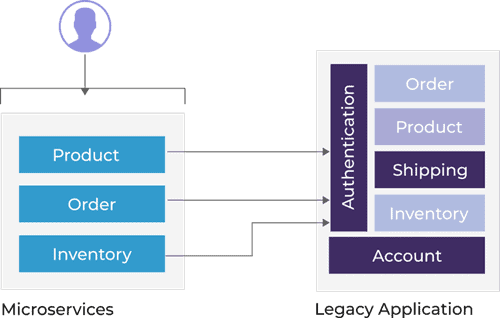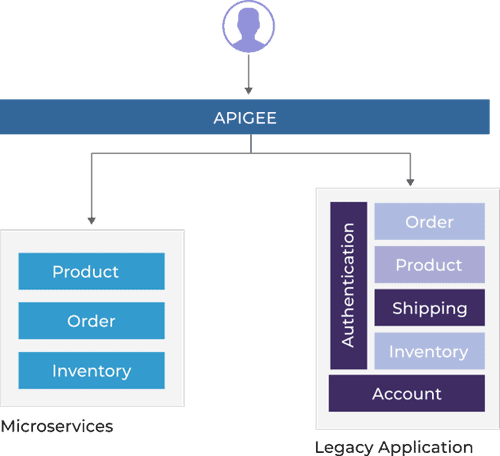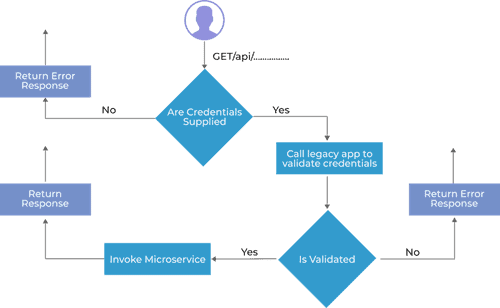Helping to migrate their legacy system to microservices by leveraging Apigee Edge platform
Introduction

As Apigee edge was part of the new microservice-based architecture, we leveraged the Apigee layer to invoke legacy authentication features on behalf of microservices.
About Royal Caribbean
Our client had a decade-old legacy system (a set of monolithic applications) to address all of the IT requirements. Today, where the software and IT requirements are very dynamic, and to drive the best consumer experience, the client needs to make rapid changes — which wasn’t possible with the existing system.
One of the prime objectives was to be agile and move fast in the digital space where they can continuously roll out new applications and services to their customer and maintain a competitive edge. We proposed adopting microservice-based architecture to serve their need for rapid rollout of the new services and to remove the brittleness (harder and a long-drawn cycle of introducing any new changes) of the existing system. Microservice are all about doing one job and doing it well; they solve the challenges of monolithic systems by being as modular as possible. In the simplest form, they help build an application as a suite of small services, each running in its process and independently deployable.
The challenge
The primary challenge was to migrate the current application to the new application while keeping everything alive and running as it is. So we decided to adopt an incremental approach for the migration and will implement one service at a time and replace the current functionality in the legacy system with that microservice.
However, some parts of the legacy application can still be used as they were serving the business well. It’s not necessary to migrate the complete system instead of finding a way to reuse the functionality of particular components in our newer architecture. One such functionality was the role-based authentication component; it was a complex functionality as multiple legacy components were involved in authenticating the user and its role. Migrating this service was a daunting task, and since it was not adding any business value, we decided to continue with legacy authentication.

To authenticate the user, all the microservices were calling the authentication feature of the legacy system. Later, we realised that it’s not idle to call legacy services through many microservices. It may activate security threats and we will have to duplicate the functionality in every service.
The solution
As Apigee edge was part of the new microservice-based architecture, we leveraged the Apigee layer to invoke legacy authentication features on behalf of microservices. Using Apigee helped us to keep our microservices agnostic to the legacy application, as Apigee was the only layer that communicated with the legacy application for authenticating the user.

In the above figure, instead of invoking the Product, Order, and Inventory microservices directly, the user makes an API call to Apigee. Apigee authenticates the API call using legacy authentication service and if the request gets authenticated, then API delegates the API call to underlying microservices; otherwise, it sends an error response to the caller.

The outcome
• By leveraging the Apigee Edge platform, our client was able to migrate legacy service into microservices incrementally while keeping the system live.
• User interaction to the system was limited to Apigee layer only, thus, keeping user agnostic to all the underlying mambo jumbo happening in the migration process.
• The new system is more secure since Apigee provides out of the box security policies for OAuth and LDAP.
Read more case studies
Building a long-term partnership with SLR Consulting
We worked with SLR to deliver a range of digital solutions including a sustainable digital business card platform, a smart room booking system for desks and parking, an automated supplier onboarding...
Accelerating transformation with Digital MGA innovator, Ripe
Ripe partnered with NashTech to accelerate the migration of data and products from their legacy platform, freeing their in-house team to focus on developing new products, a critical part of their...
Markerstudy Distribution’s Successful Partnership with NashTech
MSD’s relationship with NashTech has proven to be a game-changer, helping them scale their development capabilities, access cutting-edge technologies, and maintain a competitive edge in the...
Let's talk about your project
- Topics:
Our partnerships















